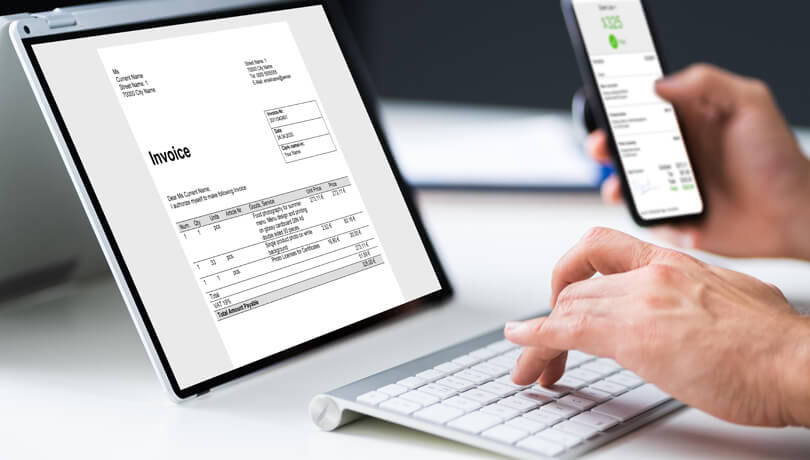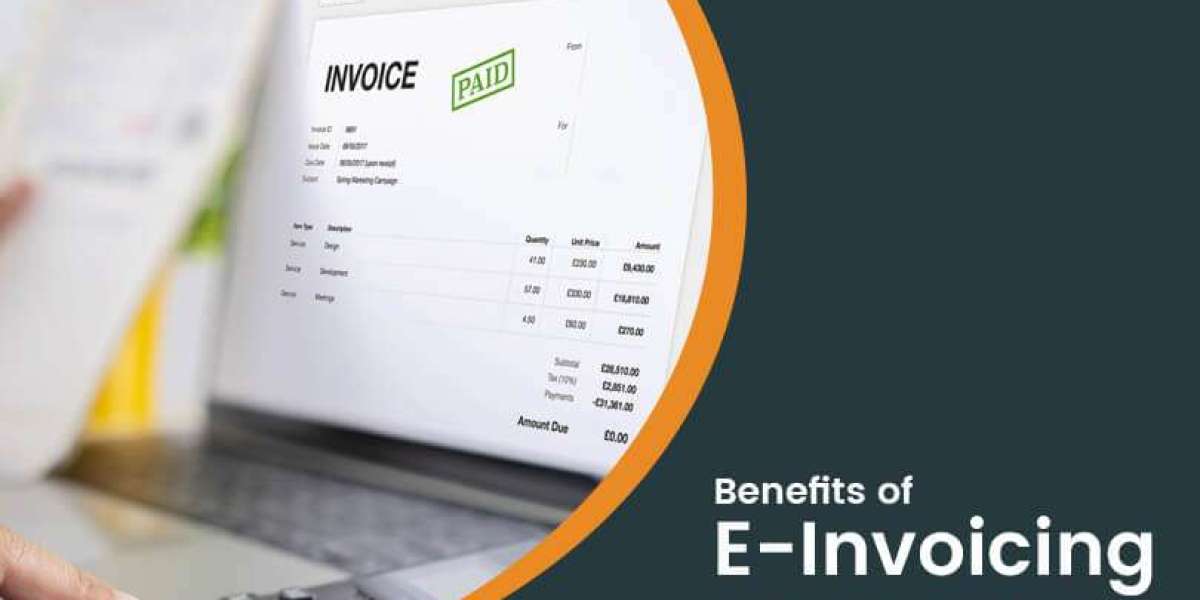In this modern era of technology, e-invoicing has become a revolutionary tool for businesses. This procedure eliminates the need for paper-based invoicing by exchanging invoices via electronic means. E-invoicing is now an essential part of contemporary finance and accounting processes as the relevance of digital transformation in business operations grows.
Integration of digital technology into all functional areas of a business is a trend known as “digital transformation.” Digital transformation has a profound impact on how firms run and provide value to their clients. E-invoicing is an essential part of digital transformation for finance and accounting companies. It plays a pivotal role in driving digital transformation within organizations. By replacing traditional paper-based invoicing methods with electronic systems, e-invoicing streamlines and automates the entire invoicing process, leading to significant efficiency gains, cost savings, and improved accuracy. Moreover, e-invoicing integrates seamlessly with other digital systems, such as accounting software, enterprise resource planning (ERP) systems, and electronic payment platforms, enabling organizations to achieve greater visibility, transparency, and control over their financial operations.
As part of the broader digital transformation agenda, electronic invoicing, or e-invoicing facilitates the digitization of financial workflows, enhances collaboration between stakeholders, and paves the way for data-driven decision-making. Furthermore, by reducing reliance on manual processes and paper-based documents, e-invoicing accelerates the pace of business transactions, enhances agility, and positions organizations to adapt to rapidly evolving market dynamics in the digital age.
Enjoy best-in-class e-invoicing features with Field Promax. Sign Up Now.
Let’s check out what e-invoicing is and what advantages it can bring to your business.

What is Electronic Invoicing?
Before we delve into its magnitude of benefits, let’s start with some basics like, “What is electronic invoicing?” to get a better understanding of the matter.
E-invoicing, short for electronic invoicing, is a digital method of creating, sending, receiving, and managing invoices between businesses electronically. Unlike traditional paper-based invoicing, e-invoicing leverages digital technologies to streamline the invoicing process, reducing manual efforts, paper waste, and processing times. With e-invoicing, invoices are generated in electronic formats such as PDF, XML, or EDI (Electronic Data Interchange), allowing for seamless integration with accounting systems and automation of payment processes. Additionally, e-invoicing facilitates real-time tracking and monitoring of invoice status, enabling businesses to improve cash flow management, enhance efficiency, and minimize errors associated with manual data entry.
In e-invoicing, the process typically begins with the generation of an electronic invoice by the seller, which includes details such as the products or services provided, quantities, prices, and payment terms. The electronic invoice is then transmitted to the buyer via email, a secure online portal, or through an electronic data interchange (EDI) network. Upon receipt, the buyer’s accounting system automatically processes the invoice, verifies its accuracy, and records the transaction. Once approved, the buyer initiates payment electronically, either through a bank transfer, credit card transaction, or other electronic payment methods. Throughout the entire process, e-invoicing systems provide visibility and transparency into the invoice lifecycle, enabling both buyers and sellers to track invoice status, resolve disputes, and streamline financial workflows efficiently.
In summary, e-invoicing automates and streamlines the invoicing process for an organization, making it more efficient and less time-consuming.
What Benefits Do Electronic Invoices Offer?
In today’s digital age, businesses can reap numerous benefits from switching to electronic invoicing. These advantages include boosted productivity, decreased costs, increased accuracy, quicker payments, improved cash flow management, heightened security, and increased sustainability. Businesses can enhance their operations and remain competitive by implementing e-invoicing. Therefore, let’s briefly explain each below.
- Greater Efficiency
In comparison, e-invoicing is more effective than traditional paper-based invoicing. Companies can automate their invoicing process using e-invoicing, eliminating the need for human data entry and lowering the possibility of mistakes. The creation of invoices can be automated, saving time and effort compared to manual processing, by integrating the invoicing procedure with already-in-use corporate systems, such as accounting software. This method of invoicing is more effective, freeing up time and resources to handle other crucial business activities.
- Save Money
By removing the need for printing, shipping, and physical storage of invoices, e-invoicing enables firms to save money. Invoicing may be expensive, especially for companies that deal with many invoices. However, businesses can save money with e-invoicing by doing away with the requirement for physical documents and speeding up invoice processing. Companies can use the significant cost savings from this to invest in other value-added operations.
- Better Accuracy
With e-invoicing, less manual data entry, which is susceptible to error, is required. The likelihood of errors is decreased through automated data capture, ensuring all data is appropriately captured. It improves the invoicing process’s accuracy, reliability, and efficiency, enabling firms to keep better records. It also allows companies to monitor the invoicing procedure closely, ensuring that all bills are completed appropriately and promptly.
- Faster Payments
By lowering the time needed to process and approve invoices, e-invoicing can help businesses get paid more quickly. In the past, processing invoices manually consumed a lot of time. However, e-invoicing simplifies the procedure, drastically reducing the time needed to validate and manage invoices. Faster payment processing and cash flow management result from strengthening a company’s financial position and freeing it up to invest in business expansion prospects.
- Better Cash Flow Management
Businesses can manage their cash flow more effectively thanks to real-time access to their accounts receivable provided through e-invoicing. Companies may have to wait weeks or months to get paid using conventional invoicing techniques. With e-invoicing, businesses can track payments and better manage their cash flow, enabling them to make wise decisions and seize new possibilities as they present themselves. Additionally, it allows companies to budget for upcoming costs and investments, ensuring they have the money to support their growth goals.
- Enhanced Security
Businesses may protect their sensitive data with the help of increased security measures like encryption and authentication offered by e-invoicing. Traditional invoicing techniques sometimes rely on tangible items that can be stolen or lost. E-invoicing, however, enables businesses to guarantee that their data is safe and shielded from illegal access. Thus, there is less risk of misrepresentation and information penetration, which can be exorbitant and harm an organization’s standing.
- Improved Sustainability
By removing the need for paper invoices, electronic invoicing can assist organizations in lowering their environmental impact. It creates a more sustainable company model by reducing paper usage, waste, and carbon emissions. By minimizing the need for transportation, e-invoicing also assists businesses in lowering their carbon footprint and the overall environmental impact of their operations.
Take advantage of paperless business solutions to enhance your operations. Book your Free Demo with us to learn more.

What is the Role of E-Invoicing in Digital Transformation?
Electronic invoicing is a critical component of the digital revolution and is gaining importance in our modern marketplace. It can transform how companies run their operations by presenting chances for cost savings, higher productivity, and an improved customer experience. So here below, we deeply understand its essential roles for businesses:
- Optimizing Operations
By automating formerly manual operations like data entry and processing, e-invoicing enables organizations to optimize their invoicing process. Automation of the invoicing process boosts productivity, reduces mistake rates, and saves time and money. It can help your employees decrease the payment processing workload, enhance cash flow management, as well as address the risks of payment delays.
- Supply Chain Management
Due to its ability to provide real-time visibility into invoice progress and speed up the invoice processing process, e-invoicing also substantially impacts supply chain management. Businesses may reduce the time it takes to handle bills by automating the invoice process. It will speed up the entire supply chain. With the help of e-invoicing, companies may interact with their clients and suppliers more efficiently, opening up possibilities for increased efficiency and collaboration.
- Customer Experience
By enabling businesses to offer quicker, more streamlined options for processing invoices and making payments, e-invoicing can significantly enhance the customer experience. Customers can get invoices and make payments more quickly using e-invoicing than traditional paper invoicing, increasing customer satisfaction and loyalty. Additionally, E-Invoicing gives clients internet access to their invoice history, increasing transparency and providing helpful information for research.
- Data Analytics
E-invoicing also plays a significant part in data analytics by giving companies useful information about invoicing and payment procedures. Using this data to pinpoint problem areas and enhance company procedures is possible. Businesses can also study consumer behavior and trends via e-invoicing, which helps them better, understand the wants and needs of their customers.
- Integration with other systems
E-invoicing can be coupled with other business systems, including software for accounting, gateways for payments, and customer relationship management (CRM) technologies. Organizations can increase data accuracy, eliminate human labor, and streamline operations through this interface. Businesses can automate the invoicing process, from creating invoices to collecting payments, and acquire a complete understanding of their operational processes by integrating E-Invoicing with other systems.

How to Implement E-Invoicing in Your Business?
Considering the multitude of advantages, e-invoicing can be a huge competitive advantage for any organization. However, many business owners refrain from utilizing it, thinking this to be an additional burden on their existing workload. Indeed, embracing new technologies can be challenging. But if you know how to manage it efficiently, no goal is impossible.
In fact, implementing e-invoicing in a service organization is rather simple. Here is a step-by-step guide for you:
- Assess Current Processes
Begin by assessing the organization’s current invoicing processes, including how invoices are generated, distributed, and managed. Identify pain points, inefficiencies, and areas for improvement that e-invoicing can address.
- Select E-Invoicing Solution
Research and select an e-invoicing solution that aligns with the organization’s needs, budget, and technical requirements. Consider factors such as scalability, integration capabilities with existing systems (such as accounting software), security features, and user-friendliness.
- Customize Templates
Customize e-invoicing templates to include relevant information such as service descriptions, pricing, payment terms, and branding elements. Ensure that the templates comply with legal and regulatory requirements for invoicing in the organization’s jurisdiction.
- Integrate with the Accounting System
Integrate the e-invoicing solution with the organization’s accounting or enterprise resource planning (ERP) system to streamline invoice processing and reconciliation. Ensure that data flows smoothly between the e-invoicing platform and other financial systems.
- Train Staff
Provide training and support to staff members involved in the invoicing process to familiarize them with the new e-invoicing system. Train them on how to generate, send, receive, and manage electronic invoices effectively, as well as how to troubleshoot any issues that may arise.
- Communicate with Customers
Inform customers about the transition to e-invoicing and provide guidance on how they can receive and process electronic invoices. Encourage customers to provide feedback and address any concerns they may have about the new invoicing process.
- Pilot Test
Conduct a pilot test of the e-invoicing system with a small group of customers or transactions to identify any potential issues or areas for improvement before rolling out the system organization-wide.
- Monitor and Evaluate
Continuously monitor the performance and effectiveness of the e-invoicing system, gathering feedback from internal stakeholders and customers. Evaluate key metrics such as invoice processing times, error rates, and customer satisfaction to measure the impact of e-invoicing on the organization’s operations and finances.
- Optimize and Expand
Based on feedback and performance metrics, make adjustments and optimizations to the e-invoicing system as needed. Consider expanding e-invoicing capabilities to include additional features such as electronic payment options, automated reminders, and analytics dashboards to further improve efficiency and productivity.
The Ultimate Way to Implement Electronic Invoicing in A Service Business
If you think choosing an electronic invoicing solution that integrates with your existing systems would be a difficult task, there is an easier alternative—switch to Field Promax!
Field Promax is an all-in-one service automation solution that offers everything on a single platform, including e-invoicing. Using this software, you can take care of all your day-to-day tasks, including job management, scheduling, dispatch, monitoring, reporting and analytics, inventory management, time-tracking, estimating, and, of course. e-invoicing—all in one place. Moreover, Field Promax supports seamless integration with QuickBooks and Stripe, thus simplifying your accounting and online payment processing as well.
The best thing about Field Promax is that it is optimized for mobile devices, available on both iOS and Android. This means even your field technicians can create e-invoices and accept payments directly from the job site, using their smartphones or tablets.



